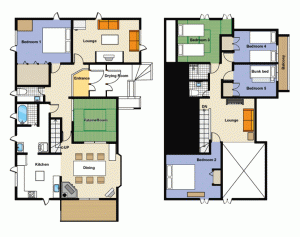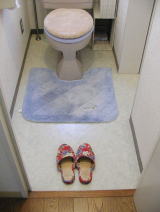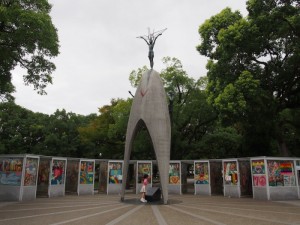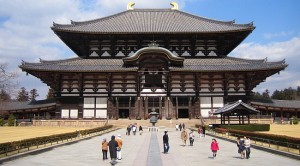 Todaiji. A major Buddhist temple in Nara.
Todaiji. A major Buddhist temple in Nara.

The giant Buddha in Todaiji.
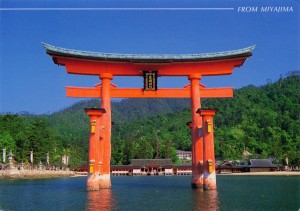
Itukushima shrine on Miyajima.
The Basic Teachings of Buddha
(TEMPLES!)
The “Four Noble Truths”
- There is suffering and impermanence in life for all beings.
- There is a cause for suffering, which is attachment and desire.
- There is a way out of suffering, which is to eliminate attachment and desire.
- The way out of suffering is the “Noble Eightfold Path”
“Noble Eightfold Path”
- Right Understanding means to understand the Four Noble Truth.
- Right Thoughts means thought free of ill-will, cruelty or desire.
- Right Speech means to refrain from pointless and harmful talk… to speak kindly to all.
- Right Action means to see that our deeds are peaceable and compassionate.
- Right Livelihood means to earn our living in such a way as to entail no evil consequences.
- Right Effort means to direct our efforts continually to the overcoming of ignorance and desires.
- Right Mindfulness means to be aware of one’s deeds, words and thoughts.
- Right Meditation means to meditate on the Oneness of all life and the Buddhahood that exists within all beings.
Shinto at a glance (SHRINES!)
The essence of Shinto is the Japanese devotion to invisible spiritual beings and powers called kami, at shrines, and at various rituals.
Shinto is not a way of explaining the world. What matters are rituals that enable human beings to communicate with kami.
Kami are not God or gods. They are spirits that are concerned with human beings – they appreciate our interest in them and want us to be happy – and if they are treated properly they will intervene in our lives to bring benefits like health, business success, and good exam results.
Shinto is a very local religion, in which devotees are likely to be concerned with their local shrine rather than the religion as a whole. Many Japanese will have a tiny shrine-altar in their homes.
However, it is also an unofficial national religion with shrines that draw visitors from across the country. Because ritual rather than belief is at the heart of Shinto, Japanese people don’t usually think of Shinto specifically as a religion – it’s simply an aspect of Japanese life. This has enabled Shinto to coexist happily with Buddhism for centuries.
- The name Shinto comes from Chinese characters forShen(‘divine being’), and Tao (‘way’) and means ‘Way of the Spirits’. 神道
- Shrine visiting and taking part in festivals play a great part in binding local communities together.
- Shrine visiting atNew Year しょうがつ is the most popular shared national event in Japan.
- Because Shinto is focused on theJapan it is clearly an ethnic religion. Therefore Shinto is little interested in missionary work, and rarely practiced outside
- Shinto sees human beings as basically good and has no concept of original sin, or of humanity as ‘fallen’.
- Everything, including the spiritual, is experienced as part of this world. Shinto has no place for any transcendental other world.
- Shinto does not require adherents to follow it as their only religion.
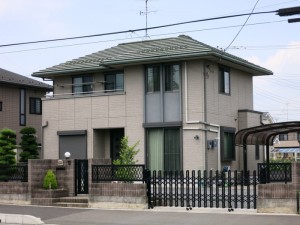
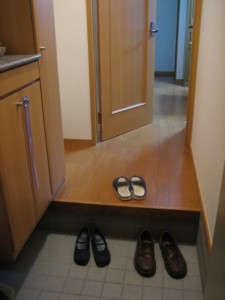 A typical genkan (entrance way) Notice the placement of the shoes and slippers.
A typical genkan (entrance way) Notice the placement of the shoes and slippers. Step out of your shoes and into the slippers.
Step out of your shoes and into the slippers.

